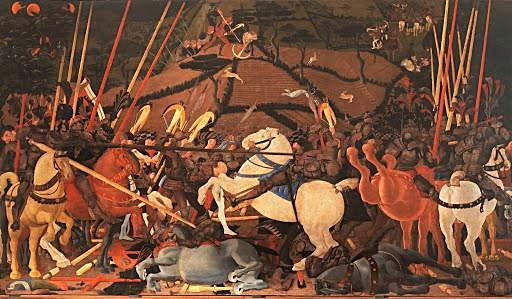Skilled realist painters exhibit their exceptional talent by immortalizing various human experiences on canvas. British painter Frank Craig, for instance, brilliantly depicted the awe-inspiring bravery and valiant conduct of Joan of Arc, fondly known as the Maid of Orleans, in his masterpiece titled “The Maid”. This artwork portrays Joan leading the French cavalry fearlessly into battle.
In this captivating painting, Craig strategically used red lances to direct the viewers’ attention towards Joan as she fearlessly charges forward. Her poised yet fierce demeanor showcases her courage as she charges headlong into the enemy lines, accompanied by her troops. Clad in a white surcoat over her armor, Joan holds a massive white flag bearing the image of the Virgin Mary, symbolizing their ultimate protector.
Craig’s skilled brushwork brings the battle to life before our eyes. The impactful imagery transports us to a tumultuous scene filled with battle cries, the thunder of horse hooves, and the charge of foot soldiers. The cavalry, with lances held high, bravely charges forward amidst a volley of enemy arrows. Each moment is filled with action and tension, as the cavalry skillfully evades arrows while some unfortunate soldiers fall victim to the lethal projectiles.
Art enthusiasts can witness Craig’s magnificent painting, along with other equestrian artworks, at the Palace of Versailles. The Horse in Majesty – At the Heart of a Civilisation exhibition showcases over 300 remarkable works, including splendid equestrian and cavalry armor dating from the 1500s to the 1800s.


Another notable painter, Brown, excelled in capturing genre scenes, hunting, and military depictions such as the American Revolutionary War, the Seven Years War, and the Franco-Prussian War of 1870.
In a different artwork, Morot vividly paints a thunderous cavalry charge during the Battle of Rezonville near the village of Mars-la-Tour in France. The foreground showcases cavalrymen skillfully clashing swords, their bodies contorted in both attack and defense. Among the chaos, one unfortunate soldier and his horse succumb to the commotion, destined to be trampled by the advancing troops in the background.

During the period spanning from the 1500s to the 1800s, European armorers not only crafted steel suits for cavalrymen, foot soldiers, and tournament participants, but also created elaborate armor as diplomatic gifts and for special occasions like parades and ceremonies.

Among the exhibition’s noteworthy pieces are two late-Gothic shaffrons, on loan from The Metropolitan Museum of Art collection, attributed to the Milanese armorer Romain des Ursins. These shaffrons feature a German-style crinet and a simple yet striking design that perfectly contours to the horse’s face. Nineteenth-century additions include ear and eye guards, as well as the crinet’s mail fringe and lame that protect the mane.

Ursins also created a fearsome dragonhead shaffron for the French court. The magnificent dragon design draws inspiration from legends and literature. Decades later, court armorers embellished the shaffron for Dauphin Henry II of France, incorporating finely finished gold-damascened dolphins, fleur-de-lis, and the letter H, transforming it into a befitting accessory for the future king’s steed.

In the late 16th century, an anonymous French armorer crafted an extraordinary ceremonial helmet. This heroic-style helmet showcases intricate engravings, chasings, and damascening, depicting a chaotic battleground where men on warhorses fiercely clash. Some riders charge aggressively towards the enemy, while others face their final moments. The presence of holes at the helmet’s base indicates where it would have been riveted or laced with leather to connect it to the body armor.

Anton Peffenhauser, a renowned German armorer, demonstrated immense skill in the art of armor crafting. Working in Augsburg, Germany, during the latter half of the 16th century, Peffenhauser was the town’s preeminent armorer. His expertise is showcased in the striking suit of armor and barding owned by the Dresden State Art Collections in Germany. Peffenhauser designed the suit, seamlessly linking it to the armor of the knight. The peytral, flanchards, and crupper gracefully drape down the horse’s chest, sides, and rump, appearing more like fabric than steel. Intriguingly, even the reins are covered in plate metal to ensure they could not be severed during the heat of battle. Peffenhauser embellished every surface with exquisitely detailed nature-inspired flourishes.

Horses, adorned with armor, were often covered with cloth caparisons extending from their heads to tails. Interestingly, caparisons were sometimes referred to as “barding”, as seen in Nuremberg tournament and parade albums featuring vibrant illustrations of colorful bardings from the 16th and 17th centuries. These albums provide glimpses into the pageantry and splendor of that era, showcasing bachelor jousts alongside detailed depictions of knights’ names, coats of arms, and comical aspects of their characters.

The exhibition pays homage to the significant role horses play in human civilization. Observing the exhibition’s historic battle art and armor grants us a deeper appreciation for the exceptional skills of armorers who dedicated themselves to protecting soldiers. Furthermore, it serves as a reminder of the immense sacrifices and hard-fought battles endured by our ancestors.
Discover more from Tension News
Subscribe to get the latest posts sent to your email.

